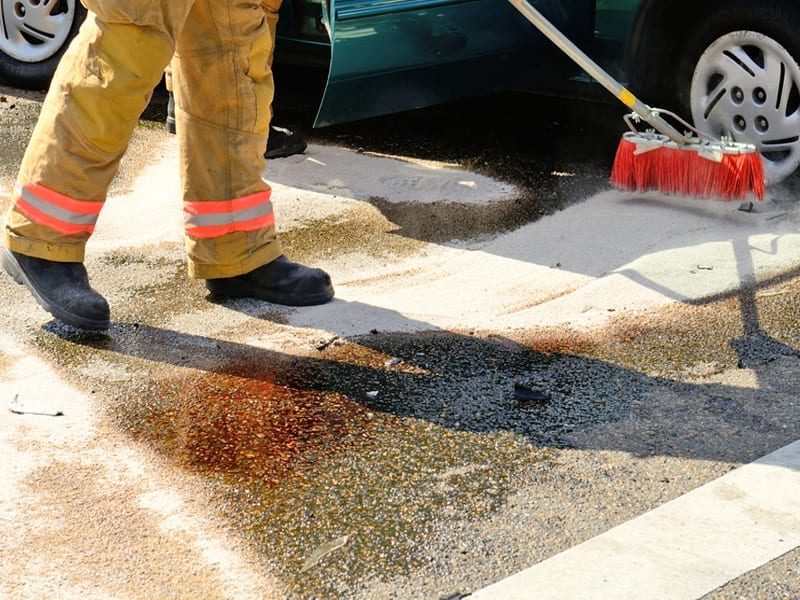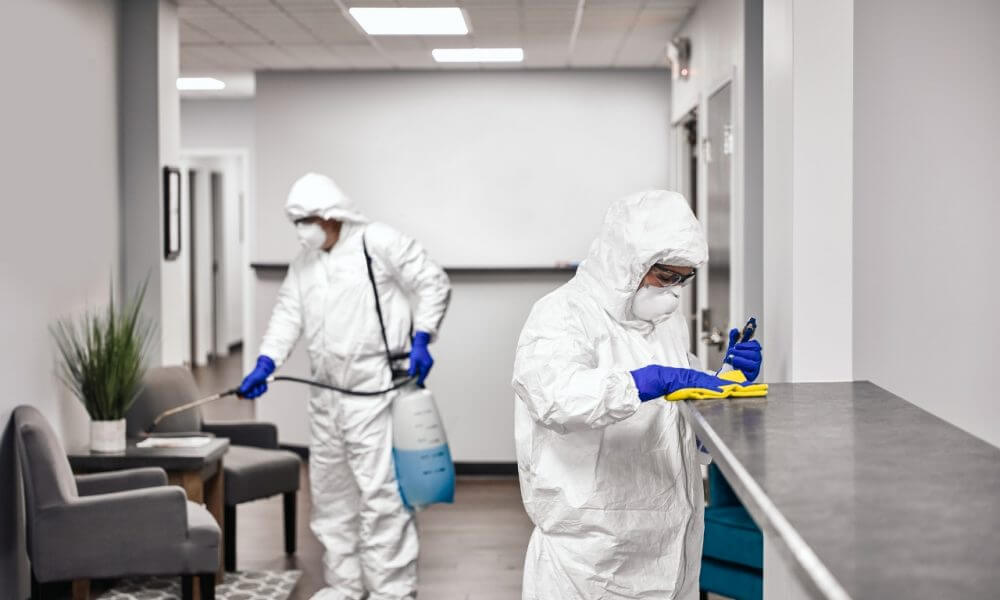Biohazard Removal: Safe Handling and Disposal of Hazardous Products
Biohazard Removal: Safe Handling and Disposal of Hazardous Products
Blog Article
Professional Biohazard Cleaning and Decontamination for Blood, Bodily Fluids, and Hazardous Products
The prospective health dangers linked with exposure to biohazards highlight the important demand for thorough handling and extensive cleanup. As we browse the complex landscape of biohazard cleaning, recognizing the nuances of regulations, compliance, and the customized equipment at play becomes crucial in making sure a thorough and risk-free decontamination process.
Wellness Dangers of Biohazard Direct Exposure
Direct exposure to biohazards poses considerable wellness threats that can cause serious consequences for neighborhoods and people alike. Biohazards incorporate a broad array of organic substances, consisting of blood, physical liquids, mold, bacteria, infections, and other possibly contagious products. When individuals come right into contact with these biohazards, whether via accidents, inappropriate handling, or ecological direct exposure, they face the risk of contracting major diseases or conditions.
Among the key health and wellness risks connected with biohazard exposure is the transmission of contagious conditions. Bloodborne microorganisms such as HIV, liver disease B and C, and numerous bacteria can be existing in biohazardous materials, presenting a direct danger to human health. Inhaling airborne biohazards like mold spores or coming right into call with infected surface areas can also bring about respiratory problems, allergies, and other damaging health and wellness impacts.
Additionally, biohazard direct exposure can have long-term health and wellness implications, with some diseases showing up years after the initial get in touch with (Blood Cleanup). Consequently, it is essential to prioritize correct biohazard cleaning and decontamination to alleviate these health threats and ensure the security of neighborhoods and people

Specialized Educating for Biohazard Cleanup
When it involves managing biohazard cleanup effectively and securely, specialized training plays a fundamental duty in guaranteeing correct decontamination treatments are complied with. Biohazard clean-up requires particular knowledge and abilities to properly alleviate threats connected with bloodborne virus, bodily fluids, and harmful products. Experts educated in biohazard cleaning undertake rigorous direction on how to safely handle, get rid of, and dispose of biohazardous materials to stop contamination and direct exposure.
Specialized training for biohazard cleaning covers a variety of necessary subjects, consisting of correct individual protective devices (PPE) use, bloodborne microorganism understanding, decontamination strategies, and harmful waste disposal protocols. People learnt biohazard cleaning are outfitted with the necessary proficiency to examine contamination levels, recognize possible hazards, and execute appropriate cleaning treatments in conformity with governing requirements.
Constant training and education are paramount in the field of biohazard cleanup to remain updated on the most recent decontamination modern technologies, safety protocols, and regulations. By buying specialized training, biohazard clean-up specialists can effectively reply to emergency situation cleanup scenarios and secure both public health and wellness and the setting.
Relevance of Appropriate Decontamination Methods
Using proper purification techniques is vital in biohazard cleaning to efficiently minimize and remove hazardous products health risks. Reliable decontamination not only ensures the removal of noticeable traces of blood, physical fluids, and various other biohazards however additionally targets unseen pathogens that may posture significant wellness dangers otherwise correctly removed. By complying with stringent purification methods, trained specialists can significantly minimize the danger of exposure to dangerous bacteria, viruses, and microorganisms that could result in infections or conditions.
Proper decontamination strategies involve the usage of customized equipment and disinfectants that are especially made to neutralize biohazards effectively. Complete cleaning and sanitation of polluted areas are important to avoid the spread of microorganisms and make sure a risk-free atmosphere for passengers. Additionally, the appropriate disposal of biohazardous waste adhering to purification procedures is vital in preventing contamination of other surfaces or people.

Devices and Devices for Safe Cleaning
The appropriate tools and tools play an important duty in making sure the effective and secure cleanup of biohazardous products. When taking care of blood, bodily fluids, or dangerous products, biohazard cleansing experts rely upon specialized gear to reduce direct exposure risks and extensively decontaminate the afflicted area. Personal safety tools (PPE) such as handwear covers, goggles, masks, and coveralls are important to shield against straight call with possibly contagious materials. Additionally, biohazard cleansing kits including anti-bacterials, absorptive materials, and biohazard bags are used to securely consist of and dispose of polluted things. Blood Cleanup.
Advanced cleaning tools like hospital-grade disinfectants, HEPA-filtered vacuums, and misting machines are utilized to sterilize surfaces why not find out more and remove biohazards effectively. Specialized devices such as sharps containers and biohazard waste disposal bins are made use of to securely take care of sharp objects and biohazardous waste materials. By making use of the best tools and devices, biohazard cleaning professionals can ensure a detailed clean-up procedure that focuses on security and reduces health and wellness risks for both workers and residents of the damaged space.
Rules and Conformity in Biohazard Cleansing
Appropriate adherence to policies and compliance standards is vital in biohazard cleaning to ensure the security of both personnel and the setting. Government agencies such as OSHA (Occupational Security and Health And Wellness Administration) and the EPA (Epa) have developed specific standards for biohazard cleanup treatments to minimize health dangers and environmental contamination. These guidelines cover a series of elements including the handling, transportation, and disposal of biohazardous products, as well as the needed training and safety devices required for employees involved in the cleanup process.
Biohazard cleansing firms should remain updated with these guidelines to guarantee that their procedures satisfy the needed safety requirements. Failing to comply with these laws can cause severe consequences, consisting of penalties, lawful action, and threatening the health and wellness of individuals and the atmosphere. By complying with strict policies and compliance measures, biohazard cleaning companies can efficiently reduce threats and make sure a risk-free and thorough cleaning procedure for all parties involved.
Verdict
In verdict, biohazard cleansing and decontamination need specific training, correct methods, and adherence to guidelines. Exposure to blood, bodily liquids, and harmful materials poses significant health threats, making it essential to use the ideal equipment and tools for risk-free clean-up. By complying with rigorous procedures and standards, professionals can successfully reduce the threats connected with biohazard direct visit our website exposure and make certain the safety of both themselves and others.
As we navigate the intricate landscape of biohazard clean-up, understanding the nuances of laws, conformity, and the specialized equipment at play ends up being crucial in making certain a detailed and risk-free purification process. (Blood Cleanup)
When it comes to dealing with biohazard cleanup successfully and safely, specialized training plays an essential duty in making certain proper purification procedures are adhered to.Using correct decontamination strategies is vital in biohazard cleaning to efficiently remove hazardous materials and lessen wellness threats. Additionally, biohazard cleansing sets including anti-bacterials, absorbing products, and biohazard bags are utilized to safely consist of and get rid of of contaminated products.
Federal government agencies such as OSHA (Occupational Safety and Wellness Administration) and the EPA (Environmental Defense Agency) internet have actually developed certain guidelines for biohazard cleaning treatments to reduce health dangers and ecological contamination.
Report this page